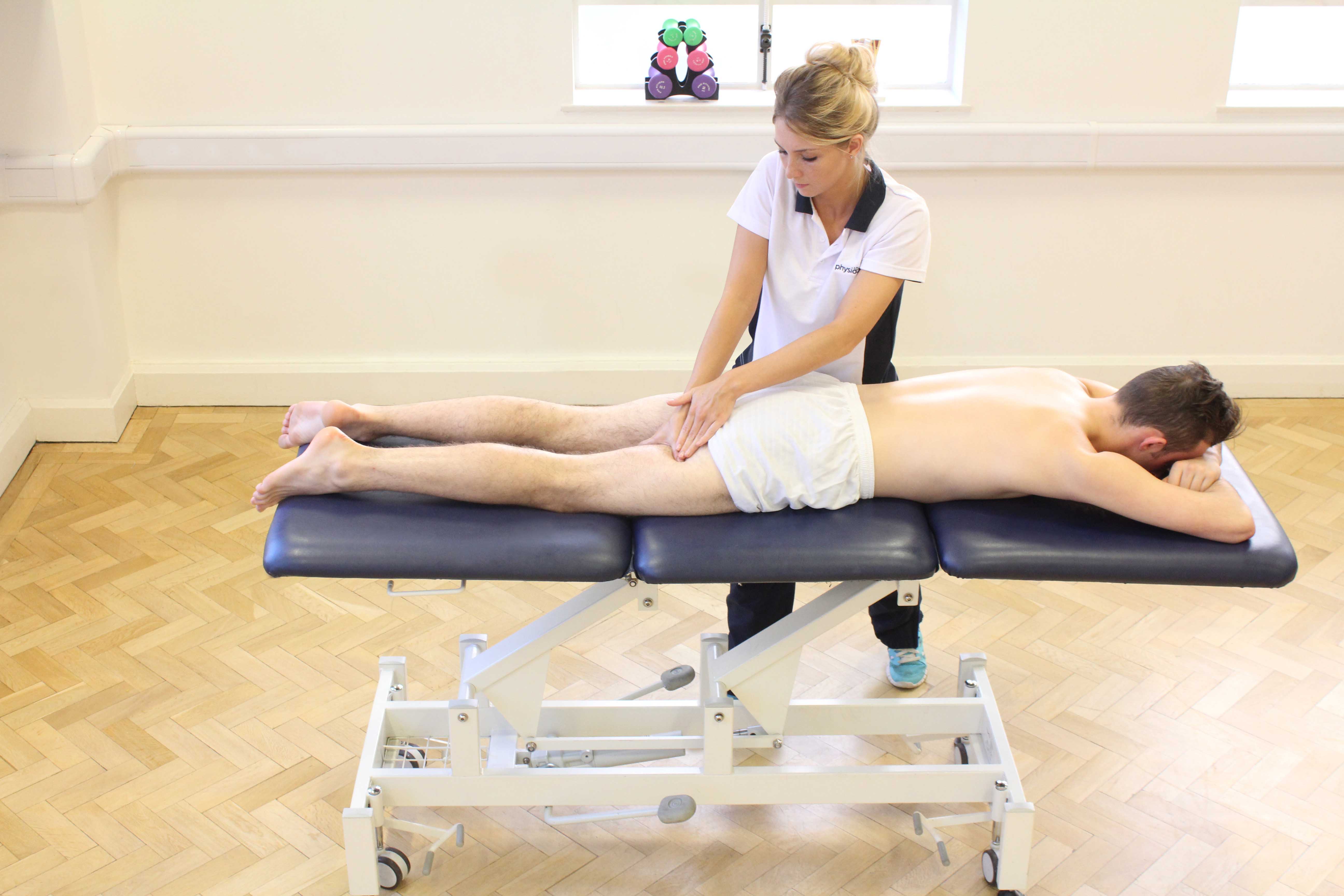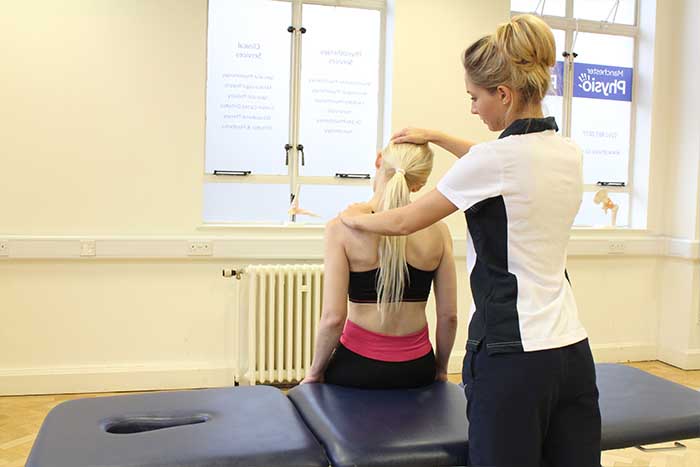Massage treatment can benefit an individual with lymphedema. Lymphedema refers to an accumulation of lymphatic fluid within one area, also known as swelling. Lymphedema can occur due to a number of reasons such as surgery, injury or pregnancy. The therapists at Physio.co.uk can use specific massage techniques to reduce the presence of lymphedema and achieve a reduction in pain and stress and an improvement in range of movement.
What is massage for lymphedema?
Lymphedema, also known as swelling is a collection of fluid within one area of the body. Swelling is commonly observed within the body's extremities such as the arms or legs. There are a number of causes of lymphedema such as post-injury, post-surgery or pregnancy. Lymphedema occurs when the body is unable to remove lymphatic fluid naturally. The lymphatic system is a major component of the body's natural immune system which is comprised of vessels which run throughout the whole body. The function of the lymphatic system is to transport lymph cells such as white blood cells to injured areas to address infection or damage. The lymphatic system, when functioning properly is involved in transporting toxins, lymphatic fluid and waste products towards lymph nodes where they can be filtered and expelled from the body. When the lymphatic system is overrun or working inefficiently lymphedema can occur.

When can massage help for lymphedema?
Massage therapy can benefit an individual suffering from lymphedema during a number of circumstances such as;
 Above: Soft tissue massage of the hamstring muscles to clear excess fluid
Above: Soft tissue massage of the hamstring muscles to clear excess fluidMassage therapy can help an individual following surgery such as cosmetic or reconstructive surgery. During invasive surgical procedures, the body undergoes stress and damage. In response to surgery the body stimulates an increase in lymphatic fluid containing lymph cells and white blood cells to the damaged area to remove damaged or dead cells. Massage techniques such as lymphatic drainage can be used to assist the body's natural lymphatic system to carry lymphatic fluid containing waste products to lymph nodes where the fluid can be filtered. Lymphatic drainage techniques can reduce pain and swelling and promote healing and range of movement.
Massage therapy can also be used during pregnancy. Swelling within the ankles, feet and fingers is common during pregnancy due to the increased volume of fluid present. Swelling is not harmful to the baby or mother however it can cause reduced range of motion and pain. Lymphatic drainage massage applied to the ankles, feet and hands can help decrease the lymphatic fluid pressure felt within, and therefore improve range of motion, functional performance and reduce pain.
Massage therapy can also be beneficial to an individual post-injury. When injury or damage occurs a rush of lymphatic fluid containing white blood cells and lymph cells flood the area to remove damaged or dead cells and fight infection. Massage therapy can assist the lymphatic system by pushing the white and lymph cells carrying dead and damaged cells towards lymph nodes where they can be filtered. Sometimes an injury can remain in the swelling phase of healing due to an ineffective lymphatic system, resulting in chronic swelling. Massage therapy can reduce chronic swelling and promote healing to progress by stimulating blood flow and assisting the lymphatic system to remove the excess lymphatic fluid.
What are the physiological effects of a massage for lymphedema?
Massage can produce a number of physiological effects which can benefit an individual experiencing lymphedema. The physiological effects include;
Massage can increase capillarisation. Capillarisation refers to an increase in the number of capillaries that surround tissues. Capillaries are small blood vessels responsible for transferring blood containing nutrients and oxygen into the tissues from the blood stream. An increase in the number of surrounding capillaries means an increase in the supply of oxygen and nutrients which will aid the muscle to perform and repair. Massage can stimulate an increase in capillarisation which can also improve the health of muscles due to an increase in the removal of waste products.
Massage can increase lymphatic drainage. Lymphatic drainage refers to a process involving the removal of waste products from tissues into the blood to be later filtered and expelled from the body. Massage can stimulate lymph flow through the application of specific massage strokes directed towards the body's lymph vessels. Massage can assist lymph flow to lymph nodes where the fluid can be filtered and the waste within removed. An increase in lymphatic drainage can also produce a reduction in swelling, delayed onset of muscular soreness and an increase in muscular performance.
Massage treatment can remove waste products. Massage can assist in the removal of metabolic waste products through assisting blood and lymph flow. Massage can improve blood circulation which can assist in the removal of waste products from the body's tissues to the bloodstream via the capillaries. Massage can improve lymph flow containing metabolic waste products towards lymph nodes where the lymphatic fluid can be filtered and removed from the body. A reduction in waste products within the body's tissues can also decrease pain, maintain the health of muscles and reduce feelings of fatigue.

What are the benefits of a massage for lymphedema?
The application of massage can produce a number of benefits available to an individual suffering from lymphedema. The benefits of massage include;
Massage therapy can help reduce swelling. Swelling can occur during a number of circumstances such as injury, surgery or pregnancy. Massage using lymphatic drainage techniques which involve gentle, long and slow strokes directed towards the body's lymph nodes can be used to reduce swelling. A reduction in swelling is achieved by altering the volume of lymphatic fluid within an area by pushing it towards lymph nodes. Lymph nodes are small organs which are responsible for filtering lymphatic fluid. By reducing the swelling within the area the individual will also feel a reduction in pain and an increase in range of movement.
Massage can help increase relaxation through gentle and long massage strokes. Massage can stimulate the production of natural endorphins, serotonin and dopamine. Elevated levels of serotonin can result in the individual feeling happy with a sense of well-being. Increased levels of dopamine can leave the individual feeling motivated and enthusiastic. Massage can also restrict the production of the hormone cortisol. Cortisol is a hormone released during times of threat to enable the body to be alert and aware, however prolonged periods of high cortisol can leave the individual feeling anxious and depressed.
Massage can also be used to decrease pain. A reduction in pain can be achieved through the pain gate theory. The pain gate theory states a non-painful stimulus (massage) can override a painful stimulus (swelling) when messages are being sent to the brain via the spinal pathway. The pain gate theory explains how an individual experiences a reduction in pain as their brain does not receive pain messages. A reduction in pain can also lead to an improvement in range of movement and reduction in stress.
Massage therapy can also be used to improve the range of motion in the joint surrounded by lymphedema. Lymphedema can restrict the movement of joints due to filling the space needed for range of movement. Massage techniques such as lymphatic drainage can improve range of movement by pushing the excess fluid from the joint to surrounding lymph nodes where the lymphatic fluid can be filtered and removed.
Summary
Massage can be extremely beneficial when applied during periods of lymphedema. Lymphedema can occur for many reasons but most commonly post-surgery, pregnancy and post-injury. The application of massage can produce a number of physiological effects which can be beneficial to the individual such as increased capillarisation, lymphatic drainage and removal of waste products. The physiological effects produced during massage can lead to the individual experiencing a reduction in swelling and pain and an increase in range of movement and relaxation. Overall, massage treatment can be extremely beneficial physiologically but also psychologically as the treatment is enjoyable and relaxing.
How can I arrange a massage?
To arrange a massage to help lymphedema at Manchester Physio, email us at office@manchesterphysio.co.uk or call us on 0161 883 0077.
You can also book an appointment online and save £10.

 0330 088 7800
0330 088 7800



































